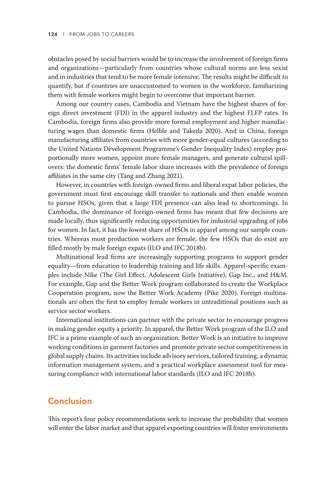124
l
FROM JOBS TO CAREERS
obstacles posed by social barriers would be to increase the involvement of foreign firms and organizations—particularly from countries whose cultural norms are less sexist and in industries that tend to be more female intensive. The results might be difficult to quantify, but if countries are unaccustomed to women in the workforce, familiarizing them with female workers might begin to overcome that important barrier. Among our country cases, Cambodia and Vietnam have the highest shares of foreign direct investment (FDI) in the apparel industry and the highest FLFP rates. In Cambodia, foreign firms also provide more formal employment and higher manufacturing wages than domestic firms (Helble and Takeda 2020). And in China, foreign manufacturing affiliates from countries with more gender-equal cultures (according to the United Nations Development Programme’s Gender Inequality Index) employ proportionally more women, appoint more female managers, and generate cultural spillovers: the domestic firms’ female labor share increases with the prevalence of foreign affiliates in the same city (Tang and Zhang 2021). However, in countries with foreign-owned firms and liberal expat labor policies, the government must first encourage skill transfer to nationals and then enable women to pursue HSOs, given that a large FDI presence can also lead to shortcomings. In Cambodia, the dominance of foreign-owned firms has meant that few decisions are made locally, thus significantly reducing opportunities for industrial upgrading of jobs for women. In fact, it has the lowest share of HSOs in apparel among our sample countries. Whereas most production workers are female, the few HSOs that do exist are filled mostly by male foreign expats (ILO and IFC 2018b). Multinational lead firms are increasingly supporting programs to support gender equality—from education to leadership training and life skills. Apparel-specific examples include Nike (The Girl Effect, Adolescent Girls Initiative), Gap Inc., and H&M. For example, Gap and the Better Work program collaborated to create the Workplace Cooperation program, now the Better Work Academy (Pike 2020). Foreign multinationals are often the first to employ female workers in untraditional positions such as service sector workers. International institutions can partner with the private sector to encourage progress in making gender equity a priority. In apparel, the Better Work program of the ILO and IFC is a prime example of such an organization. Better Work is an initiative to improve working conditions in garment factories and promote private sector competitiveness in global supply chains. Its activities include advisory services, tailored training, a dynamic information management system, and a practical workplace assessment tool for measuring compliance with international labor standards (ILO and IFC 2018b).
Conclusion This report’s four policy recommendations seek to increase the probability that women will enter the labor market and that apparel exporting countries will foster environments


